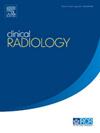阐明基于计算机断层扫描(CT)的放射组学生物标志物在浆液性卵巢癌中的生物学功能
IF 2.1
3区 医学
Q2 RADIOLOGY, NUCLEAR MEDICINE & MEDICAL IMAGING
引用次数: 0
摘要
目的:本研究旨在通过基于预测生存的放射学特征的综合基因集富集分析(GSEA)从图像中读取肿瘤微环境中的生物学机制。此外,该研究利用放射学特征对生存预测进行生物学解释,从而实现最佳治疗反馈,以改善临床结果。材料与方法本回顾性研究纳入浆液性卵巢癌患者的预处理CT图像。使用最小绝对收缩和选择算子(LASSO)-Cox回归选择预后放射学特征,并计算为rad评分。将患者分为低危组(hrg)和高危组(hrg),建立生存预测模型。采用Kaplan-Meier曲线、log-rank检验和C-index对模型性能进行评价。GSEA确定了与生存相关的放射学特征相关的基因组。结果Kaplan-Meier曲线采用log-rank检验(p<0.01), c指数值(0.768;95% CI: 0.694-0.842)的预测模型差异有统计学意义。对低水平和hrg进行GSEA,结果确定了一组与细胞增殖相关的基因,包括G2M检查点(p=0.006, FDR=0.138),有丝分裂纺锤体(p=0.006, FDR=0.156)和E2F靶点(p=0.032, FDR=0.133)。结论本研究揭示了对生存预测至关重要的影像学特征的生物学功能,并引入了放射基因组学的创新方法。这种全面的方法有望为肿瘤微环境提供新的见解,并可能有助于卵巢癌治疗的进展。本文章由计算机程序翻译,如有差异,请以英文原文为准。
Elucidating the biological function of computed tomography (CT)-based radiomics biomarkers in serous ovarian cancer
AIM
This study aims to elucidate the biological mechanisms in the tumour microenvironment as read from images by comprehensive Gene Set Enrichment Analysis (GSEA) based on radiomic features that predict survival. Furthermore, this study enables biological interpretation of survival prediction using radiomic features, which in turn allows for optimal treatment feedback to improve clinical outcomes.
MATERIAL AND METHODS
This retrospective study included serous ovarian cancer patients with pretreatment computed tomography (CT) images. Prognostic radiomic features were selected using least absolute shrinkage and selection operator (LASSO)-Cox regression and calculated as a Rad-score. Patients were classified into low- and high-risk groups (HRGs), and a survival prediction model was constructed. Model performance was evaluated with Kaplan–Meier curves, the log-rank test, and the C-index. GSEA identified gene sets associated with radiomic features linked to survival.
RESULTS
The Kaplan–Meier curve using the log-rank test (p<0.01) and C-index values (0.768; 95% CI: 0.694–0.842) of the predictive models showed significant differences. GSEA was performed on the low- and HRGs, and the results identified a set of genes associated with cell proliferation, including the G2M checkpoint (p=0.006, FDR=0.138), mitotic spindle (p=0.006, FDR=0.156), and E2F targets (p=0.032, FDR=0.133).
CONCLUSION
This study revealed the biological functions underlying imaging features crucial for survival prediction and introduced an innovative approach to radiogenomics. This comprehensive approach promises to provide novel insights into the tumour microenvironment and potentially contribute to advancements in ovarian cancer treatment.
求助全文
通过发布文献求助,成功后即可免费获取论文全文。
去求助
来源期刊

Clinical radiology
医学-核医学
CiteScore
4.70
自引率
3.80%
发文量
528
审稿时长
76 days
期刊介绍:
Clinical Radiology is published by Elsevier on behalf of The Royal College of Radiologists. Clinical Radiology is an International Journal bringing you original research, editorials and review articles on all aspects of diagnostic imaging, including:
• Computed tomography
• Magnetic resonance imaging
• Ultrasonography
• Digital radiology
• Interventional radiology
• Radiography
• Nuclear medicine
Papers on radiological protection, quality assurance, audit in radiology and matters relating to radiological training and education are also included. In addition, each issue contains correspondence, book reviews and notices of forthcoming events.
 求助内容:
求助内容: 应助结果提醒方式:
应助结果提醒方式:


